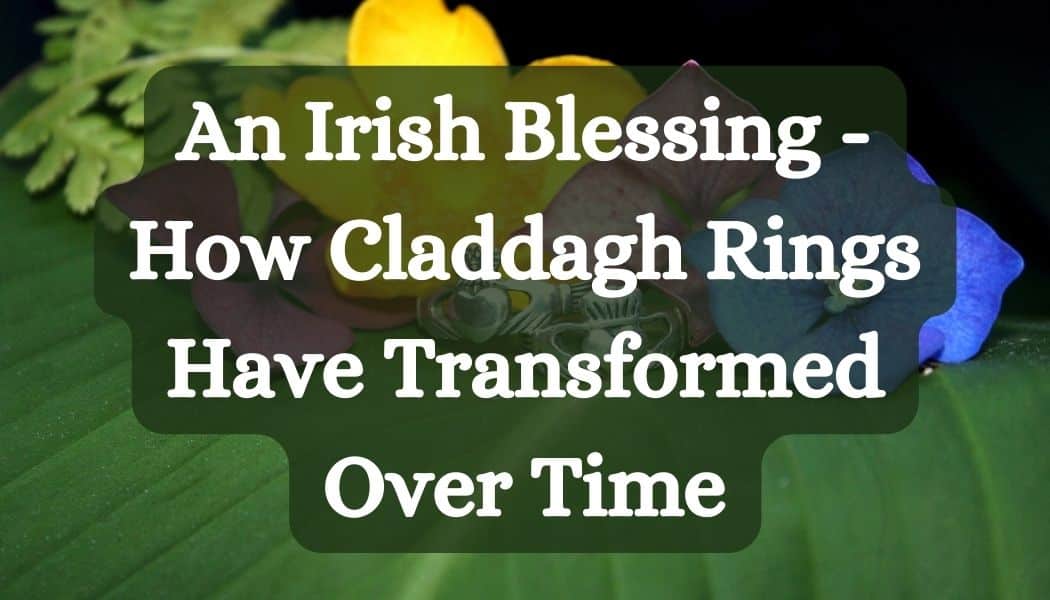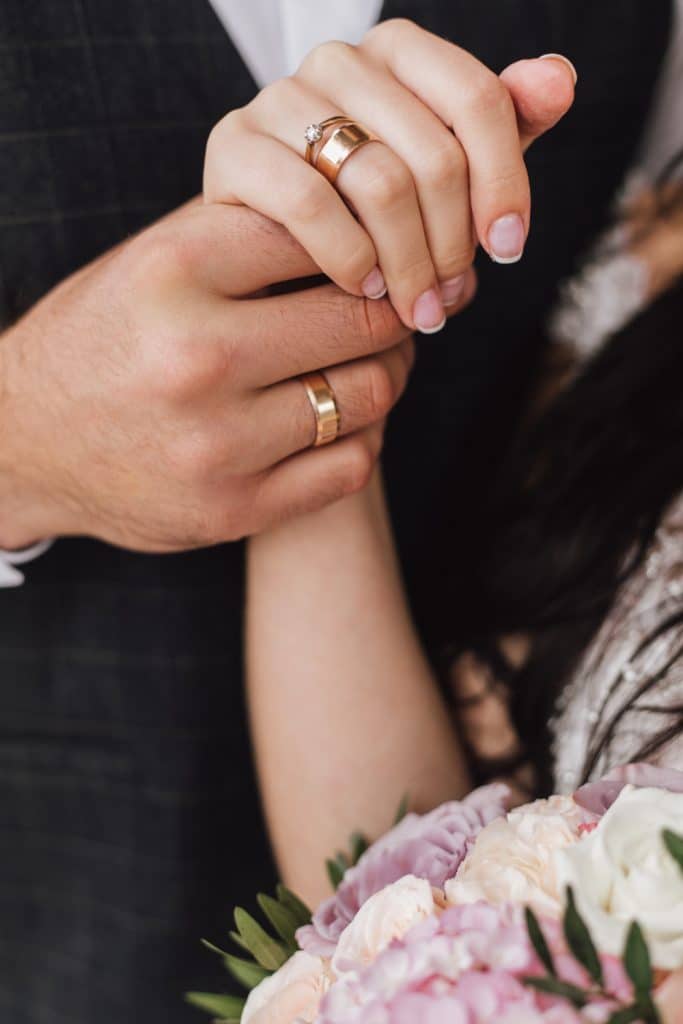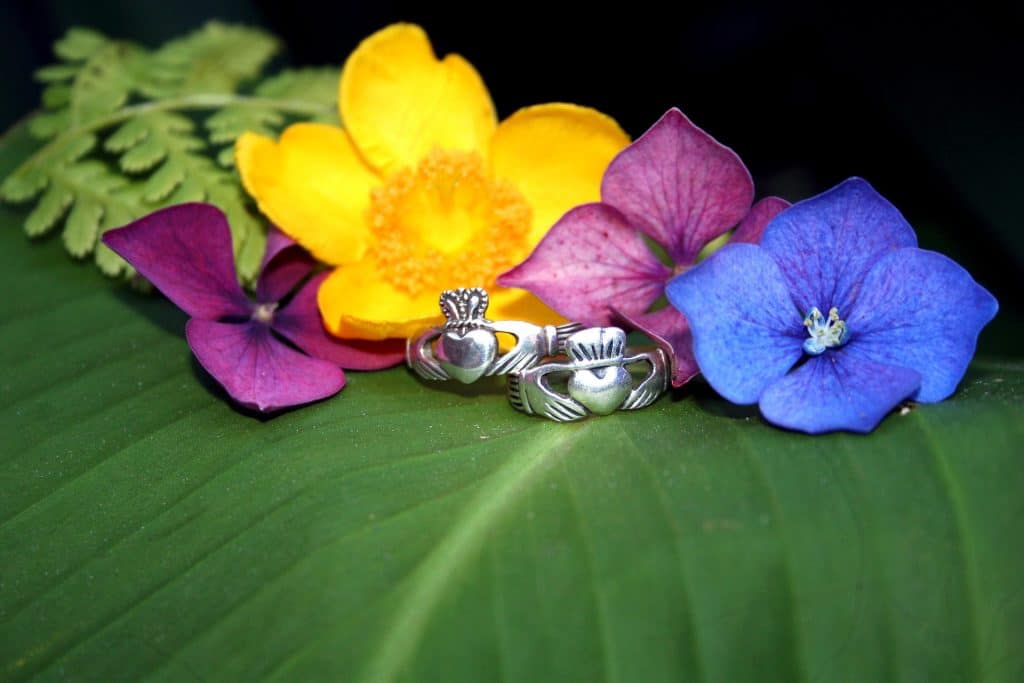
An enthralling and age-old symbol of love, the unparalleled beauty of Claddagh rings has been cherished by the Irish and people across every continent. Named after a small fishing village in Ireland, these unique rings embody deep emotions integrating love, friendship and loyalty.
The renowned design features two hands clasping a heart crowned above, symbolizing ‘let love and friendship reign.’ Even though it’s an ancient icon believed to have originated in the late 1600s, its allure continues to resonate with modern generations.
Its relevance has primarily been preserved thanks to its popularity among engaged couples, signifying their love and setting their commitment in stone as they approach their wedding.
Despite transforming over time as per changing fashion trends and materials used for crafting them, each Claddagh ring sustains its authentic essence, capturing hearts all around!
So stay tuned as we embark on this journey to understanding how Claddagh rings have evolved while still holding onto their core symbolism and significance.
Table of Contents
A Brief Overview of the Evolution Over Centuries
Firstly, let’s quickly go over the significant milestones in Claddagh ring designs before breaking down these elements in more detail later. In their early inception during the final years of the 17th century, these Irish tokens were simple and purely symbolic without much ornamentation.
Fast forward to a few centuries later, and we witnessed an explosion of creativity centred around these emblematic pieces. This was sparked thanks to their popularity as a token of love, used to seal engagements and celebrate weddings worldwide.
The fact that Irish immigrants to the US in the past three hundred years have left a thriving population of ancestors Stateside helped catalyze this growth. With time rolling further ahead, profound changes surfaced in terms of design variations and embellishments, thanks to evolving aesthetics and craftsmanship techniques.
Intricate carvings replaced minimalistic designs, and precious gemstones sparkled amidst formerly mundane metal bands, signalling increasing luxury offerings for wearers from all walks of life!
So, as you can see, while still adhering to traditional symbolism, today’s Irish love rings from providers like Claddagh Ring are more inventively designed and luxuriously appointed than the original pieces from which they draw inspiration.

A Prelude to Transformation: Early Claddagh Designs
The oldest known example of a Claddagh ring that still survives today is from 1700, yet this was undoubtedly not the first to have been made. During this nascent period, various defining features of the ring can be pinpointed, such as:
- They mainly featured simplistic and rudimentary designs, often crafted by local artisans.
- Unlike today’s fine-crafted pieces, these rings fused personal charm with a rustic aesthetic.
- Typical motifs included two hands enveloping a heart, symbolizing love and loyalty, as mentioned.
- The predominantly folk art style gradually transformed into sophisticated forms, mirroring changing societal norms and aesthetic sensibilities.
Even though there was luxury back then, it was usually reserved for the upper echelons of society due to a scarcity of materials and the time and effort involved in the production processes for jewelry. Hence, the humble origins of the Claddagh ring are reflected in the pieces from the 18th century, when an average wedding would have been a simple affair.
Gold & Silver Era: Precious Metals Enter the Fray
The metamorphosis of Claddagh rings took a significant turn during the ensuing decades following the initial introduction of the design. The shift from rudimentary calls to flamboyant ones coincided with changing metal choices and the rise of the wedding as a significant life event. Let’s dive into what happened:
- Gold and silver replaced previous lesser-expensive metals, signifying increased affluence among the general population and reflecting the expansion of the middle classes during the Industrial Revolution and the technological changes that this brought with it.
- Engravings became more intricate, reflecting improved craftsmanship and the demand for this type of design. Just as we see an ebb and flow from minimalism to maximalism in fashion today, the same was true in the 18th and 19th centuries.
- Different alloys like bronze were explored for crafting these timeless pieces. This allowed the look and feel to remain as luxurious as possible while still giving jewellers a means to keep their costs down and offering their customers budget-friendly options even as tastes were veering towards the more expensive end of the spectrum.
These transformations reflect how societal and economic changes began influencing ring styles substantially, not only in a Claddagh context but more widely across the market. The ‘hands-heart-crown’ theme evolved radiantly, with gold and silver hues making it grander than ever!
This era also marked a conspicuous leap in embellishments, with semi-precious stones often bedecking these now-luxurious adornments. This has created a debate that is still raging to this day, with some arguing that the purest form of a Claddagh ring should not have any stone set in it, while others contest that bringing a bit of bling to the design is desirable.
A Victorian Spin on Traditional Irish Rings
The Victorian age ushered a new chapter for Claddagh rings, infusing them with fresh aesthetic charm while preserving their symbolic reverence for engagement, weddings and more. This epoch’s influence manifested in several ways:
- Enamelling techniques started gaining popularity, allowing jewellers to add colour and luxury for enhanced appeal on all sorts of pieces, including rings of a Claddagh design.
- Precious gems became even more prevalent, reaching more market segments as the expansion of the British Empire and various other colonial expansion efforts by other European countries led to more resources being extracted and returned home from far-flung parts of the globe. While this was an ethical disaster from a modern perspective, it was all part of the political landscape back then.
- Pieces often exhibited intricate floral or filigree patterns, reflecting the Victorian love for details. We’re still seeing the influence of this particular fashion movement in the floral prints found in 21st-century fashion.
The reign of Victoria spanned most of the 19th century, and it wasn’t just Claddagh rings that transformed. The march of progress impacted every area of modern life and created the launch pad from which the even more significant shifts of the 20th century could be fired.
Modern Elegance Meets Ancient Roots
As we entered the modern era filled with creative diversity, Claddagh rings continued to evolve but in surprising fashions:
- Modern touches introduced sleeker designs, aligning with minimalist aesthetic trends. This could be seen as a dulling of the folk-linked heritage of these rings, but the core meaning was almost always retained thanks to the much-vaunted triumvirate of the heart, hands and crown.
- Precious metals like platinum made a posh entry onto this scene, adding another level of sophistication for those whowho weren’t afraid to push the boat out regarding aesthetics or budget. Of course, engaged couples committed to looking after the pennies weren’t excluded either, with many other materials used.
- Diamonds started dominating as preferred stones, boosting their luxury appeal even further. In recent years, the rise of lab-grown gems has helped propel this trend even further, enabling consumers to buy jewelry not tarnished with the ethical concerns usually associated with diamond mining.
This brings us up to where we are now, with Claddagh rings sitting as part of a vast international jewelry market, forming a small but significant part and representing a dash of Celtic culture in a sea of other influences.
As mentioned, modern buyers tend to get engaged or are committed to marrying their partner. So, if you’re considering popping the question or planning your nuptials, a Claddagh ring could be a compelling option.
We’ve discussed how rings of this type are made with different materials and in new, boundary-pushing designs. This also opens things up in terms of cost. You can set your budget at almost any level, and a Claddagh ring should suit it. So even if you are having a wedding on a shoestring, you can still tap into this historic symbol as part of the celebrations.

Wearing Claddagh Rings: Top Tips and Tricks
Now that you’re an expert on Claddagh rings, it’s worth thinking about how best to wear them in the 21st century, both for matrimonial purposes and more generally. Here are some things to keep in mind in this context:
- Respect its symbolism. Each element of the ring has a profound meaning associated with it. That means you shouldn’t give or receive one lightly. It’s an obvious choice for engaged couples for this reason and will signify your bond all the more effectively.
- Pay heed to its placement on your finger. If you’re planning a wedding or already married, don this Irish charm on your left hand. For singles or others engaged romantically, the right hand is suitable. Also, think about the direction in which the heart points. Orient the ring with the heart towards you if you’re taken and in an outward configuration if you’re single and ready to mingle!
- Consider your style before picking rings that are decked out with gemstones. Not everyone looks good with an elaborate, bling-tastic ring on their finger, and the simpler Claddagh designs may be a better fit.
Another point is that the metal used in the band makes a difference in the aesthetics and the price. Some people suit silver rings better than gold, for example, whether due to their skin tone or simply their typical wardrobe.
Also, consider your wedding dress design and the colour scheme of your big day if you’re planning to incorporate a Claddagh ring into it somehow. This should steer you towards the ideal combination of materials, precious stones and other elements. If in doubt, get input from friends and family members as you plan your wedding, as they might have more insights into which ring will suit you best while helping you sidestep potential pitfalls.
Weigh up all these elements before committing to a particular ring design, and try on different versions if possible.
Final Thoughts
The journey of the Claddagh ring from its archaic origins to its modern mastery of the jewelry market is intriguing.
Now that you’ve clued up on all things Claddagh, you can decide whether this is the correct type of jewelry to wear yourself or request if you’re considering recommending it as a gift option to your significant other.
The main selling point is an engagement ring for couples gearing up to make the ultimate commitment to one another. We’ve seen an absolute explosion in the variety of engagement ring designs in recent years, with things like shaped diamonds and modern settings keeping things fresh. In this context, the revival of the Claddagh ring is another exciting example of how much choice couples have, so don’t let it slip through your fingers!
Summary: How Claddagh Rings Have Transformed Over Time
Origin & Symbolism:
- Claddagh rings, traditional Irish symbols representing love, loyalty, and friendship.
- Named after a small fishing village in Ireland.
Historical Evolution:
- Originated in the late 1600s with simple, symbolic designs.
- Evolved over centuries due to changing fashion trends and crafting materials.
- Explosion of design creativity in recent centuries due to its popularity among engaged couples.
Design Over the Years:
- Initial designs: simple and symbolic without ornamentation.
- Transition to intricate carvings, introduction of precious gemstones.
- Shift from basic metals to gold and silver, reflecting societal and economic changes.
Victorian Influence:
- Enamelling techniques added color and luxury.
- Rise in precious gem usage due to colonial expansions.
- Floral and filigree patterns reflecting the Victorian aesthetic.
Modern Touches:
- Sleeker designs aligning with minimalist trends.
- Introduction of metals like platinum and increased use of diamonds.
- Ethical considerations with the rise of lab-grown gems.
Wearing Claddagh Rings:
- Importance of respecting its symbolism.
- Guidelines on how to wear: placement on the finger and heart’s orientation.
- Consideration of personal style, skin tone, and wedding aesthetics.
FAQ: Claddagh Rings
What is a Claddagh ring and what does it symbolize?
A Claddagh ring is a traditional Irish ring representing love, loyalty, and friendship. The design features two hands clasping a heart, crowned above, symbolizing ‘let love and friendship reign.’
How has the design of Claddagh rings evolved over the centuries?
The Claddagh ring originated in the late 1600s with simple and purely symbolic designs. Over the years, as it grew in popularity, especially among engaged couples, it saw an influx of design variations, including intricate carvings, the use of precious gemstones, and changing metals from mundane to gold and silver. Today’s designs range from traditional to modern, always retaining its core symbolism.
What was the significance of Claddagh rings in the Victorian age?
During the Victorian age, Claddagh rings underwent aesthetic changes while retaining their symbolic importance. Enamelling techniques became popular, precious gems became more prevalent due to colonial expansions, and the designs often featured intricate floral or filigree patterns, mirroring Victorian aesthetic tastes.
How should one wear a Claddagh ring in the 21st century?
It’s essential to respect the symbolism of the Claddagh ring. Engaged or married individuals should wear it on their left hand, while singles or those in romantic engagements should opt for the right hand. The direction in which the heart points also matters – towards you if you’re taken and outward if you’re single. Besides, one should consider their style, skin tone, and other aesthetic factors when choosing a design.
Can I get a Claddagh ring to fit any budget?
Yes, the beauty of the Claddagh ring’s evolution is that it’s now available in various materials, designs, and price points. Whether you’re planning a lavish wedding or are on a tighter budget, there’s likely a Claddagh ring that will suit your needs and preferences.














